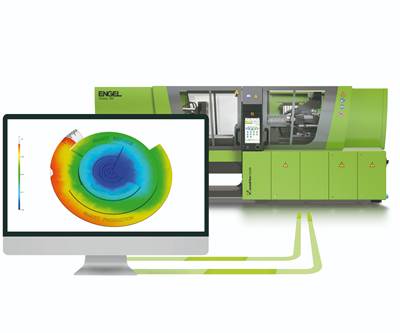A profusion of new and upgraded injection machinery at K highlighted twin themes of Circular Economy and Smart Manufacturing. While presses keep getting faster, they also grow ever more energy efficient in kWh/lb of plastic processed. The vast majority of injection machines at the show were all-electric, hybrid, and/or servohydraulic. This year’s exhibits featured machines equipped to process large amounts of post-consumer recycle (PCR) or biobased materials.
Reducing waste and downtime also contributes to more efficient and therefore more sustainable manufacturing. In that vein, K 2019 saw a continued push toward greater self-regulation in processing, greater connectivity between machines, and improved communication between humans and machines as milestones along the road to Smart Factories and Industry 4.0.
The following report presents news not covered in our September show preview and elsewhere for a more complete picture of injection molding news at the show. See also Keeping Up and Starting Up sections of this issue for additional K-related news. A report on robots will come next month.
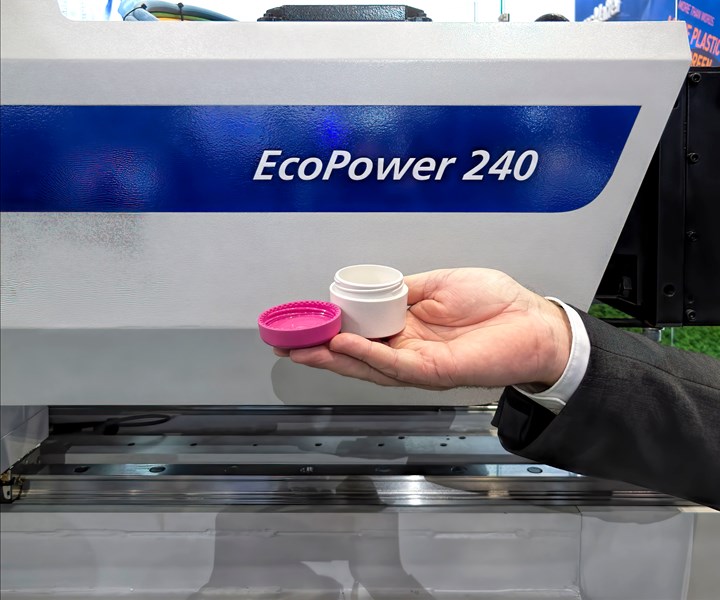
“Green” was the theme of K 2019, and Wittmann Battenfeld showed an all-electric machine specially modified to process the new Zeroplast 100% biobased, non-plastic material that is biodegradable/compostable (below) and potentially recyclable.

Going for the ‘Green’
Our September show preview highlighted several exhibits of machines from Arburg, Engel, KraussMaffei and Wilmington Machinery tailored to handle large amounts of regrind or PCR, in some cases through foaming and/or sandwich molding.
Other examples at the show included Boy Machines processing wood-plastic compound (Fibrolon from FKuR) on a Boy 125 E. Husky highlighted the ability of its newest HyPET HPP5e system to mold PET bottle preforms from 100% PCR with no sacrifice of cycle time or product quality (e.g., color). What’s more, the Husky machine can take molten PET reclaim directly via melt pipe from Erema, NGR, or other recycling systems, thereby eliminating pelletizing, crystallizing and drying steps and saving large amounts of energy. Husky says customers prefer this approach to feeding reground flake. This “RMTP” capability is expected to be commercial mid-to-late this year.Machine capabilities to process large amounts of recycle or bioplastics supported the “green” theme of K 2019.
Machine capabilities to process large amounts of recycle or bioplastics supported the “green” theme of K 2019.
Chen Hsong demonstrated three-layer sandwich molding with recycle in the core. It utilized a second injection unit and an adapter plate to divide the two streams. And Milacron showcased its M-Powered integration of iMFLUX low-pressure molding technology, which is said to adjust automatically for large variations in melt viscosity, a potential risk in processing PCR. Milacron’s multi-nozzle low-pressure injection molding (LPIM) technology for structural-foam and structural-web molding is already to handle up to 100% regrind, and testing is underway with iMFLUX on LPIM machines.
Another “green” thrust in molding exhibits involved processing of biobased materials. One impressive demonstration in this vein was Nissei’s production of champagne flutes from PLA bioresin. Nissei says PLA has poor flow characteristics, but was able to mold this deep-draw drinkware with what it claims is the thinnest wall ever molded in PLA—as thin as 0.65 mm over a flow length of 125 mm. To accomplish this, Nissei came up with a new way to inject supercritical CO2 into the melt to improve the fluidity of the material. Remarkably, the glassware is crystal clear, owing to the use of only 0.5% CO2 and the microscopic size of the gas bubbles.
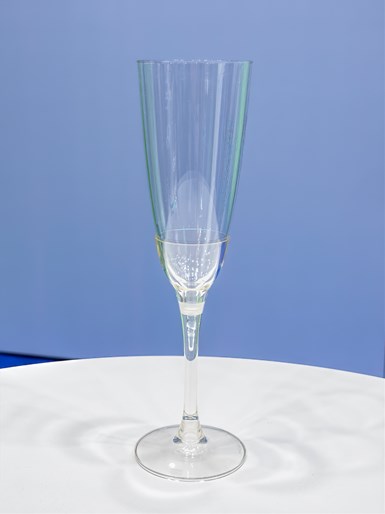
Nissei solved the problem of molding thin-wall, deep-draw parts like this two-piece champagne flute from PLA bioresin. Nissei injects supercritical CO2 into the melt to aid flow while maintaining microscopically small bubbles that don’t affect the crystal-clarity of the product. The flute was molded on Nissei’s new NEX280V-71E all-electric, Industry 4.0-ready press (below).
The glasses were molded in two parts, a base and cup in a cell utilizing two presses with Cartesian robots that deliver parts to an assembly station with a Kawasaki DuAro two-armed collaborative SCARA robot. The machine were Nissei’s brand-new, all-electric NEX 280V-71E (details below). One press molded the 185 g cups in eight cavities in 37 sec, and the other molded 108 g bases (o.74 mm thick) in four cavities in 72 sec. (Nissei will be speaking about this application in the Green Molding session at the Molding 2020 Conference, March 17-19 in Lombard, Ill.)
A new option on J-ADS all-electric machines from JSW is said to be advantageous for molding thick-wall parts from PLA and other resins. The optional JS servo drive is said to enable extended hold times together with fast injection and high responsiveness.
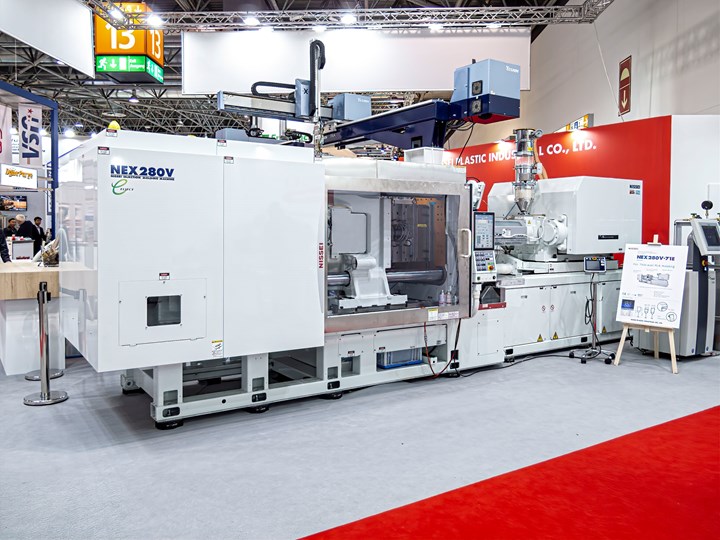
Nissei’s new NEX280V-71E all-electric, Industry 4.0-ready press.
Another unusual demonstration at K was the debut of a machine and material for molding a new kind of eco-friendly products. Zeroplast is a patented material from a Polish company of the same name (zeroplast.com) that is composed entirely of mineral and nonfood plant-derived waxes, fibers and fillers (including rice hulls and calcium carbonate). This “plastic-free” material is compostable and biodegradable in natural environments. It is also recyclable without any loss of properties, the company says. The material is said to be heat stable to greater than 200 C (392 F) in processing and to 70-75 C (158-167 F).
Zeroplast worked with Wittmann Battenfeld on an exclusive basis to develop a molding process for this material. The result is a specially modified, all-electric EcoPower 240 press (240 metric tons) with a special injection unit, heating system, and processing software. According to Wittmann sources, this system was adapted to the Zeroplast material’s sharp transition from solid to liquid and the resulting narrow process window.
At the show, Wittmann molded a thick-walled cosmetic jar and cap with the heavy feel of glass, molded in two colors in 4 + 4 cavities, with a paper in-mold label (uncoated for biodegradability) and automatic assembly of jar and lid in a screwing station outside the press. (Wittmann Battenfeld will present this innovation in the Green Molding session at the Molding 2020 Conference.)
Developments in LSR
Apart from news reported in our September K preview, Fanuc of Japan (represented here by Milacron) has developed new standard software for LSR processing on Roboshot all-electric machines of 50 to 100 tons, as well as its own screw and barrel design for this process.
Sumitomo (SHI) Demag also introduced a turnkey LSR package for its IntElect series with a special screw, nonreturn valve, vacuum system and other LSR-specific options. For the pumping/metering system, the company has partnered with Nexus Elastomer Systems of Austria.

Elmet showed its new servo-driven TOP5000E LSR dosing system with web connectivity and remote monitoring/control via mobile devices.
Elmet has shrunk its TOP 5000 P pumping system with 15% smaller footprint and 10% reduced height. Also, Elmet is developing an alternative to this pneumatically driven piston-pump system: the TOP 5000 E with servoelectric screw pump. Elmet says servo drive is more expensive and will offer the same precision as the existing version, but it is being offered to meet competition from other vendors.
Meanwhile, Elmet introduced a web-enabled Premium Connectivity Package with email functionality and remote support for the whole TOP 5000 series. All TOP 5000 dosing systems already have a VNC and OPC-UA interface for data exchange with the molding machine. The new remote-access interface allows users to change settings and monitor system status via the new Elmet Connect online portal and an app, without requiring access to the customer’s own IT network.
Incidentally, Elmet noted that the emergence of LSR 3D printing has opened up a new market. A single TOP 5000 system could feed 10 to 20 3D printers.
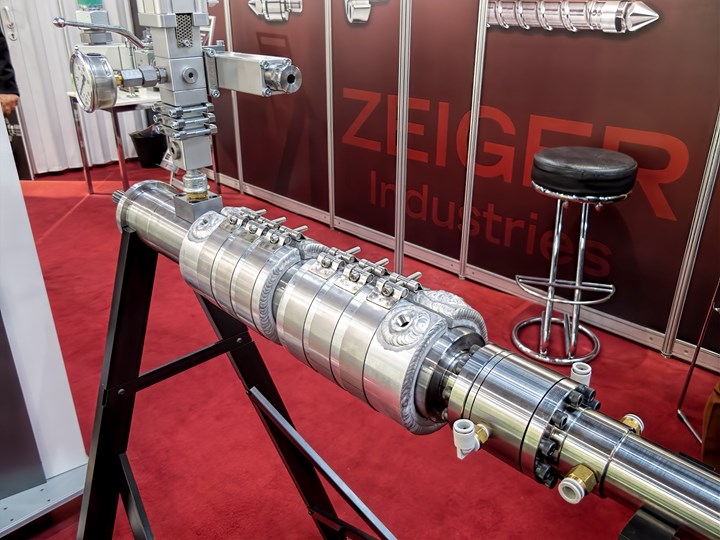
Zeiger Industries’ latest LSR conversion packaging includes quick-disconnect water jackets and a pump connection without threads that can lock up if exposed to resin leaks.
Zeiger Industries has enhanced its LSR conversion kits with new quick-disconnect water-cooling jackets for the barrel to facilitate maintenance. These also come in a toolless version. Also new is a connection to allow easier uncoupling of the pump assembly from the barrel. This version eliminates threads, reducing the risk of damage to the barrel in case of LSR leakage into the coupling, which can lock the threads.
More New Machines & Upgrades
Arburg introduced its first machine that can be configured with an app. The Allrounder 270 S compact (hydraulic, 35 m.t.), as the name suggests, has a space-saving design with reduced width and the control cabinet integrated into the machine base. It can be configured and ordered online with an app on Arburg’s customer portal in a few simple steps. The customer benefits from faster delivery and prices about 25% lower than standard hydraulic machines, Arburg says.
Arburg also initiated the spread of features launched with the new hybrid Allrounder “H” series at K 2016 to other Allrounder lines. At this show, the all-electric 570 A (200 m.t.) and 630 A (250 m.t.) appeared for the first time with the new “H” series clamp design, exterior styling, and Gestica controller with gesture-based commands.
Another introduction from Arburg was the vertical, hydraulic Allrounder 1600 T (200 m.t.) with a larger (1600-mm) servo-electric rotary table for automated overmolding of metal inserts.
Boy Machines introduced a couple of new features not previously reported: an electric slide table for the Boy 35 E VH with vertical clamp, and integration of a Regloplas TCU with the Procan Alpha controller on a Boy XS (10 m.t.), enabling mold temperatures to be displayed and adjusted on the press control screen (via Euromap 82.1 protocol).
Chen Hsong is offering several new lines of machines, not all of which were at the show. The Jetmaster MK6 line of servohydraulic toggle presses comes in 88 to 668 m.t. The clamp, base, and injection unit have all been redesigned and beefed up. Also redesigned is the Jetmaster Large SVP/2 series from 650 to 3000 m.t. New Evolution MK6e servohydraulic toggles (90 to 650 m.t.) are a lower-cost version said to be suitable for 80% of the market. The powerpack has been downsized somewhat, so these machines are not optimal for high-volume or high-torque production. There’s also a smaller new low-cost line, Focus SVP/2 from 20 to 60 m.t. At the higher-performance end is the new Speed series of servohydraulic toggles (128 to 468 m.t.) with a “top-of-the-line,” high-response servomotor for ultra-high-speed injection. The related new Speed-Pack series (260 to 470 m.t.) has longer screws, up to 26:1 L/D. Finally, a new all-electric series is the Spark line from 100 to 230 m.t., boasting a more compact and more open design.
Fanuc has a new standard execution for medical Roboshot machines, including such features as stainless-steel construction, special screws, HEPA filter, and new “bush-less” tiebars.
JSW introduced its patented SOFIT foam injection technology. It involves injecting nitrogen gas into the barrel in a decompression zone after the melting zone and before the metering/compression zone. A special screw and barrel are required, but a cost-saving feature is the ability to feed nitrogen directly from a storage tank via a pressure-reducing valve, with no need for a high-pressure metering pump.
KraussMaffei showed the new Netstal Elios 4500 (450 m.t.) high-speed, hybrid toggle press. The series was launched at NPE2018 with a 750-tonner, which is now supplemented by models of 450, 550, and 650 m.t. Also new was a 21.5-in. multi-touch display on the KM CX 80 hydraulic machine with a PLC control based on the KM MC6.
Advanced controls and extended processing range are coming to low-pressure structural-foam machines.
Milacron showed its new Q-Series of servohydraulic toggle presses and hinted that an all-electric version is on the way—perhaps to debut in October at this year’s Fakuma show in Germany.
In addition, several new features have been introduced to Milacron’s LPIM line, including the Mosaic+ control, which has VNC capability to mirror control screens from third-party auxiliaries like robots and hot-runner controls (for the latter, Milacron has standardized on Mold-Masters’ TempMaster system). This allows both monitoring and setup of the auxiliaries from the injection controller. Also new for LPIM machines is a hybrid option with a Fanuc servomotor and drive package for the screw, cutting energy consumption by 20-25%. Other new features available for LPIM machines in the last year are a 7-in.-diam. extruder capable of plasticating 3200 lb/hr, 4500-in.3 accumulator, and 10,000-psi injection-pressure capability, vs. the standard 6000 psi.
MHS Mold Hotrunner Systems brought its latest M3 micromolder (shown at NPE2018) to K with one new feature—an integrated vision system that can check part dimensions or ensure that all parts are removed from the mold within 5 millisec.
Negri Bossi (which is 75% owned by Nissei since November) showed the first model of Nova iP servohydraulic hybrid two-platen presses in a 1000-m.t. version. This is an extension of the Nova i hybrid toggle line introduced in 2018.
Negri Bossi also displayed a Cambio St servohydraulic toggle press outfitted with the new Motus control system (from B&R in Austria) with 21.5-in. multitouch display. It has a finger-operated mini-joystick that can be used in setup mode to move the screw, clamp and ejector. This is the same controller used on the new Nova s servohydraulic toggle and Nova i series. Coming soon is a new injection unit for Cambio presses.
Also on display was one of the new Nova e 130T all-electric presses converted to an injection-blow molding system by means of a mold from Molmasa of Spain. The tool has eight preform injection and eight blowing cavities in alternating positions. A mold plate shuttles up and down to move preforms to blowing cavities. It’s suited for small to medium production. (Other tooling-related conversions of injection presses to injection-blow were shown at K 2016 by Boy, Engel and Wittmann Battenfeld.)
As noted above, Nissei previewed its NEX-V Series of all-electric injection machines for the global market. The model at the show was a 280-m.t. unit, but it will be available—starting this spring—in 30 to 360 m.t. It’s said to have one of the widest platens and longest daylights in the industry while maintaining the industry’s smallest footprint. The main new feature is the TACT5 controller, designed to be Industry 4.0-ready with OPC-UA communication protocol standard and Euromap 77 and 82 capabilities available, respectively, for integration with MES systems and with mold-temperature-control systems and hot runners. The controller has a 15-in. screen with top and bottom dual windows. Nissei says this is also is one of the first machines to conform to the upcoming ISO20430 Universal Injection Molding Machine Safety Standard.
For PET preforms, SIPA of Italy introduced an enhanced version of its hybrid XForm system, dubbed Gen4 XP. It reportedly provides a new operator experience with a 21.5-in. touchscreen with high-definition graphics, swipe functions like a smartphone, and a multifunction control knob for one-handed operation. The control features automated setup routines and an in-depth part-quality troubleshooting tutorial. The servohydraulic toggle boasts a record fast dry cycle and braking kinetic-energy recovery system. Other upgrades are increased injection rate and energy efficiency—the latter is said to be typically 0.195 kWh/kg (0.886 kWh/lb). Cycle time for a 7.5 g preform is said to be 7.5 sec. Maintenance is reportedly made easier by mounting the accumulators on a pull-out rack inside the machine frame and redesigning the oil tank so that it doesn’t have to be emptied for maintenance. What’s more, SIPA introduced a smaller size in the XForm range—250 m.t., suited to 96 cavities; existing models are 350 m.t. for 128 cavities and 500 m.t. for up to 180 cavities.
Sumitomo (SHI) Demag added models and sizes to several lines of machines. Its IntElect S high-speed, all-electric series for thin-wall and precision parts in cycles of 3 to 6 sec will gain a new larger size—500 m.t.—this year (complementing the new 500-m.t. IntElect model for general-purpose technical molding in cycles under 10 sec). Also, the IntElect Multi line of two-component machines for automotive and consumer parts will extend its size range from 100 to 180 m.t. upward to 500 m.t. this year.
Meanwhile, Sumitomo Demag’s El-Exis SP high-speed packaging hybrid series gained a new 1000-m.t. model at the upper end of its size range, aimed particularly at pail production. Accumulators provide 1000 mm/sec injection speed. At the show, it molded two 17 L PP pails (675 g each) from 50% PCR, with IML, in 12.9 sec.
Victor Taichung of Taiwan (represented by Fortune International) brought out its third-generation all-electric series, the Va III. The first machine in the line is the biggest model, 230 tons, which was displayed at K. The line will start at 50 tons. Features include an upgraded controller and linear bearings on the injection carriage. The 230-tonner has tiebar spacing of 610 × 560 mm, shot capacity of 536 g (PS), clamp stroke of 520 mm, and injection speed to 160 mm/sec.
Wittmann Battenfeld introduced a high-performance plasticating unit with modified barrier screw and improved throughput rate for molding PET blood tubes in 48 cavities on an all-electric EcoPower Xpress 160-m.t. medical machine. Also new are nonreturn valves with improved wear protection and flow engineering.
Smarter & More Connected Machines
Smart machines, smart production, and smart services—the three-part mantra of Industry 4.0 drove a lot of the news at K 2019. Arburg, for example, promoted all three as part of its “arburgXworld” (pronounced “Arburg’s world”) concept. Available in Germany since last March, it is now active globally in 18 languages. In future, all Allrounder macines will be equipped with Basis Connectivity, an IIOT (industrial internet of things) gateway to networking with higher-level software tools and the web portal.
Among the new apps available via the customer portal are the Configuration app for the new Allrounder 270 S (see above) and the MachineFinder, which enables the user to enter certain parameters—such as the material to be processed and size of the tool—and the app will recommend the Allrounder machine for the job. The MachineDashboard delivers status information and key performance indicators (KPIs) for the user’s machines. VirtualControl simulates the machine controller; while SelfService provides guided error analysis and troubleshooting. And Shop allows customers to place orders 24/7 with direct access to prices, availability and order history.
Artificial intelligence (AI) is a new frontier in the push for smarter production and monitoring.
New “digital assistants” include the “filling assistant” for the Gestica controller, which provides a 3D graphic animation of the fill level of the part in relation to the screw position; and the “plasticizing assistant,” which utilizes a memory chip integrated into the barrel to record data on the working history of the screw and barrel to facilitate predictive maintenance.
Engel’s latest initiatives in digitization include integrating processing and simulation (see Starting Up) and a program in horizontal networking via its participation in the German ADAMOS (Adaptive Manufacturing Open Solutions) consortium for Industry 4.0 and IOT solutions (adamos.com). Besides Engel, the alliance includes at least 13 other companies, such as DMG Mori, Mahr, Durr, Oerlikon, Illig, Zeiss, Software AG and ASM Solutions.
A key product of the alliance is the ADAMOS Hub, a software solution for manufacturer-independent access to applications of different providers. This one unique platform reportedly can interconnect all the machinery in a plant, eliminating “data silos” and permitting an integrated view of the operating status, settings, and performance parameters of all those machines. The Hub does not collect data from the machine, but shares access to the various controllers. The result, says Engel, can be one dashboard for a whole plant or department, rather than many dashboards for individual equipment. The result could be OEE (Overall Equipment Efficiency) calculation across all machinery, something that has not been possible before now. Another example could be monitoring energy consumption for a whole plant, with the ability to drill down to individual equipment. Another benefit would be the ability to purchase and manage apps from all providers centrally, as well as access to various providers’ customer portals. (See here for other K news from Engel.)
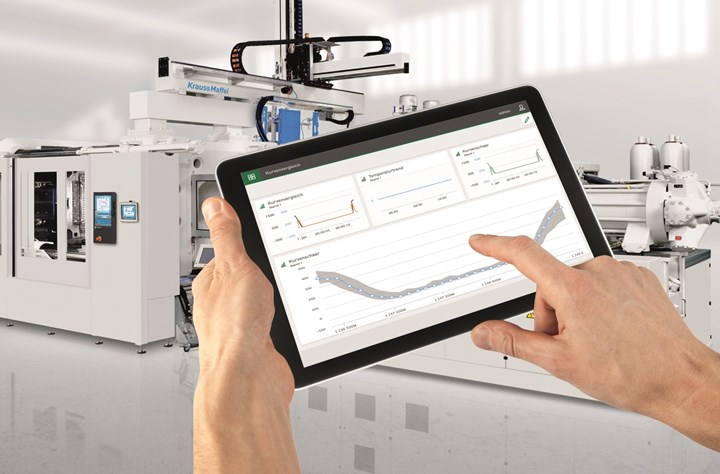
Artificial intelligence (AI) is increasingly a feature of Industry 4.0 digitization of molding operations. An example is KraussMaffei’s new app to provide early warning of production anomalies. KM plans to extend real-time production monitoring to non-KM equipment.
KraussMaffei also launched a range of new apps for digital manufacturing. New smartAssist provides immediate remote technical service at the press of a button, with audio, video and augmented-reality capabilities. New forensicExpert is a consulting service providing data-driven decision support. Via the web app, KM technicians can analyze high-resolution process data (>500 different signals every 5 millisec) for customized process optimization with no downtime during data analysis.
KM’s new socialProduction app for machine-to-human communication provides realtime production monitoring for all KM injection machines anywhere and anytime—and soon for non-KM equipment. Using AI, the app is designed to provide early identification of potential machine anomalies and then alert plant personnel. The app allows all relevant personnel to communicate easily to solve problems.
Also new is easyTrace, a central data hub for collecting all relevant production data for any age, type, and brand of machine, including extruders, injection presses, and auxiliaries (dryers, cameras, scanners, automation systems, quality test instruments, etc.). It’s described as a “lean” solution tailor made for plastics, which translates different signal-transmission protocols for communication with MES and other central plant IT systems. EasyTrace reportedly supports nearly all interfaces that exist in the market, including Euromap 63 and 77, Profinet, etc.
Milacron is tripling its workforce for digital solutions and is enhancing its M-Powered suite of Industry 4.0 services and predictive functions through partnership with ei3, a 10-year-old firm based in New York with offices in Montreal, Copenhagen and Zurich), which specializes in remote collection and analysis of industrial machine data. Ei3 believes such data “becomes more valuable when securely liberated from the plant floor.” Its latest innovation is AI developed through ei3’s Data Science center in Zurich. Milacron says this AI paves the way for new applications to support preemptive spare-parts stocking and expanded lifetime tracking for tooling and auxiliary components. Building on these capabilities, Milacron’s M-Powered is now able to interpret the data to determine impending failures, maintenance needs, or incorrect machine settings. Any Milacron machine can be enhanced with ei3 AI capabilities in less than two weeks, the company says.
New from Nissei is the N-Constellation system for networking all cell components—robots, dryers, feeders, TCUs, etc.—using Euromap communication protocols and EtherCAT, with the new TACT5 injection-machine controller as a hub. Using data collection in the cloud, this system allows centralized management of settings and performance of all connected devices. Coming soon are Nissei’s Support Cloud to provide visibility of the operating status of all connected machines, and Maintenance Assistance Cloud to analyze operating data and facilitate predictive maintenance. Nissei has also updated its PQ Manager with v3.16 of this quality and production-control system. It monitors and graphs process data and events, and sends email or text alerts.
And JSW has enhanced its Net 100 plantwide machine-monitoring system with newly upgraded J-Wise remote troubleshooting capability.

TEMIone is a new MES for a single injection machine, integrated into Wittmann Battenfeld’s B8 controller.
Meanwhile, Wittmann Battenfeld introduced a data reporting and analysis concept that does not require access to company IT systems or external (cloud) data storage. The new TEMIone “one-machine MES” package comes from Italian software firm ICE-flex (partly owned by Wittmann). This involves installing a server inside the machine control cabinet that is integrated with Wittmann Battenfeld’s B8 machine controller and Wittmann 4.0 Com-X router. This allows TEMIone to access and store production data from the press and cell peripherals to provide completed data traceability for up to five years of production. It can display customized KPIs (key process indicators) in a dashboard and an hourly OEE trend for the machine and workcell. It also merges error messages from individual devices into one clear error list. Data can be stored externally via USB or network connection.
Using AI to permit autonomous machine learning is the goal of a research project previewed at K that involves Sumitomo (SHI) Demag and the German Institute for Plastics Processing (IKV) in Aachen. This project is aimed at automated process optimization and fully automated quality control of part weight, geometry and temperature. Initial work of Sumitomo Demag and the IKV will be the basis of a publicly funded AI development project this year involving trials at a commercial molding plant.
In the meantime, Sumitomo Demag is exploring use of AI to predict part quality based on process data. For these trials, Sumitomo Demag has interfaced STASA QC software with its NC5 machine controls. STASA QC, developed by Steinbeis Angewandte Systemanalyse GmbH (Steinbeis Applied System Analysis) in Germany, is supplied by Kistler Group in its newly commercial ComoNeo Predict software. STASA QC uses machine learning to predict quality data such as part dimensions based on the cavity-pressure curve derived from in-mold sensors. The result is automated QC without time-consuming metrology tests. STASA QC software is “trained” by means of DOE configured by the software and executed automatically on an injection machine. (More details in Keeping Up section.)
Related Content
Minnesota Rubber and Plastics Opens Innovation Center
The plastics and rubber compounder and molder has opened the 9000-ft2 center that’s intended to help speed product development with design, prototyping, testing and production capabilities.
Read MoreSilicone Elastomer Course Returns
After completely filling the classroom last year, the Silicone Elastomers Technology and Fabrication course returns to Pomona, Calif. Jan. 31-Feb. 3.
Read MoreFinding a Niche in LSR Tooling
20 years ago, southern California moldmaker M.R. Mold & Engineering pivoted to LSR tooling, giving it a foothold in a challenging but growing market.
Read MoreFakuma 2023: Wittmann Battenfeld Expands All-Electric Line, Direct-Current Capabilities
Wittmann Battenfeld will introduce the new EcoPower B8X injection molding machine line and show direct current as an energy source for a concept machine that will power its own robot.
Read MoreRead Next
Simulation Is Making Injection Machines Smarter
Engel’s simlink will refine offline simulation with results from actual molding and use Engel’s machine data to constrain simulation within the actual machine’s capabilities.
Read MoreK 2019 Preview: Injection Molding Goes for the ‘Green’
‘Circular Economy’ joins Industry 4.0 as common themes of injection molding exhibits in Düsseldorf.
Read MoreInjection Molding: Artificial Intelligence Predicts Part Quality
AI software “learns” via DOE the influence of process variables on part quality and applies that “learning” to make good/bad part determination in production.
Read More


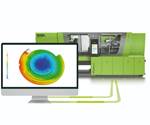

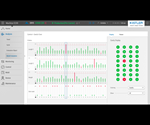







.png;maxWidth=300;quality=90)















